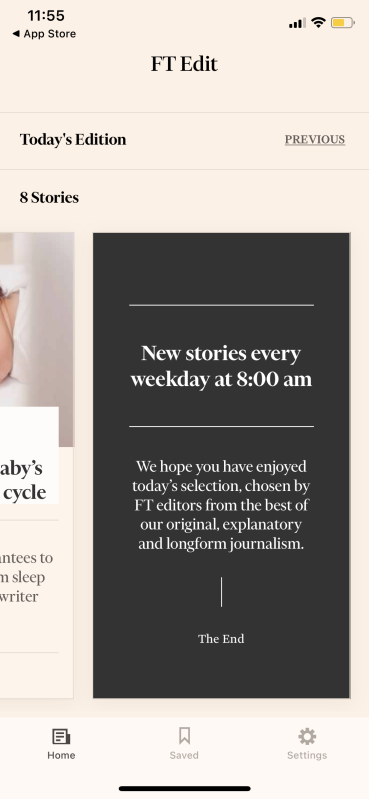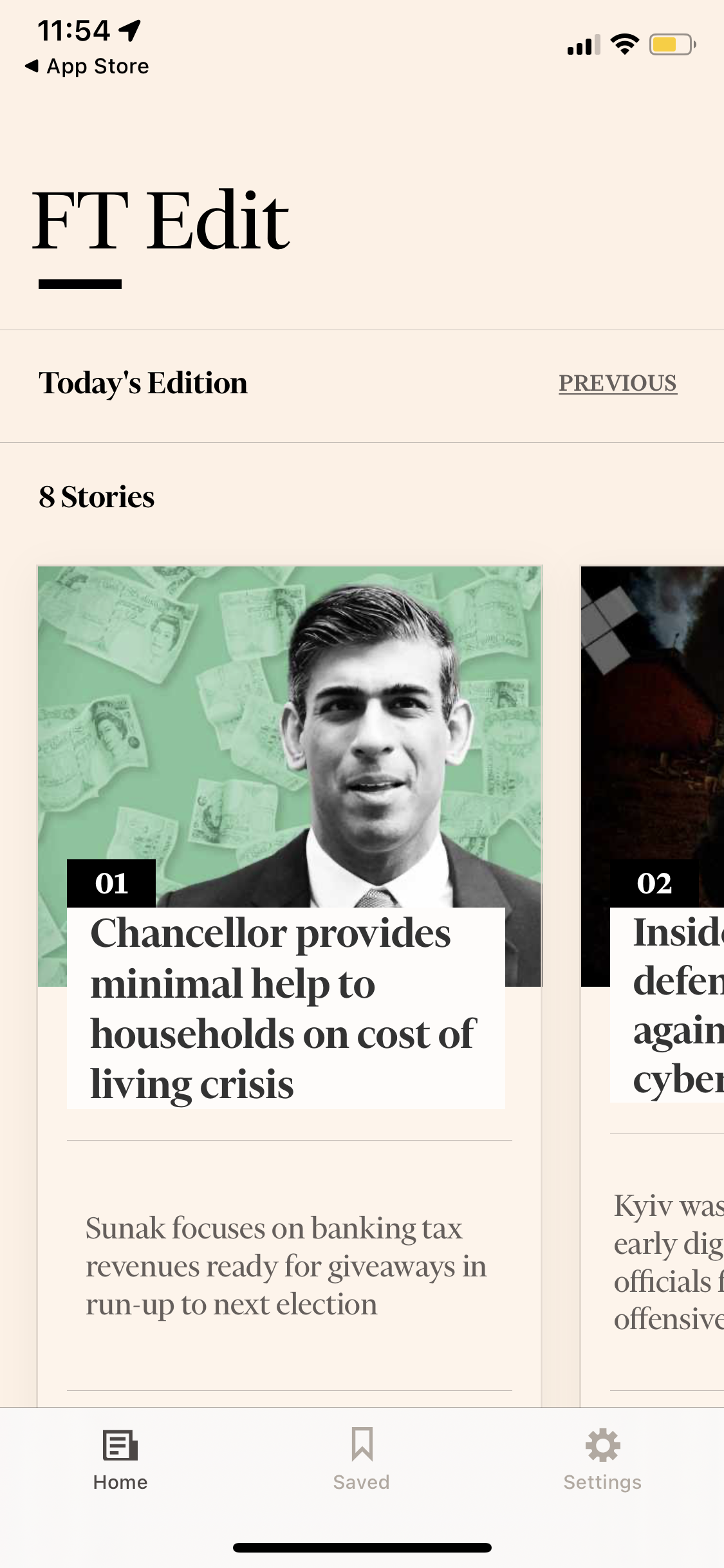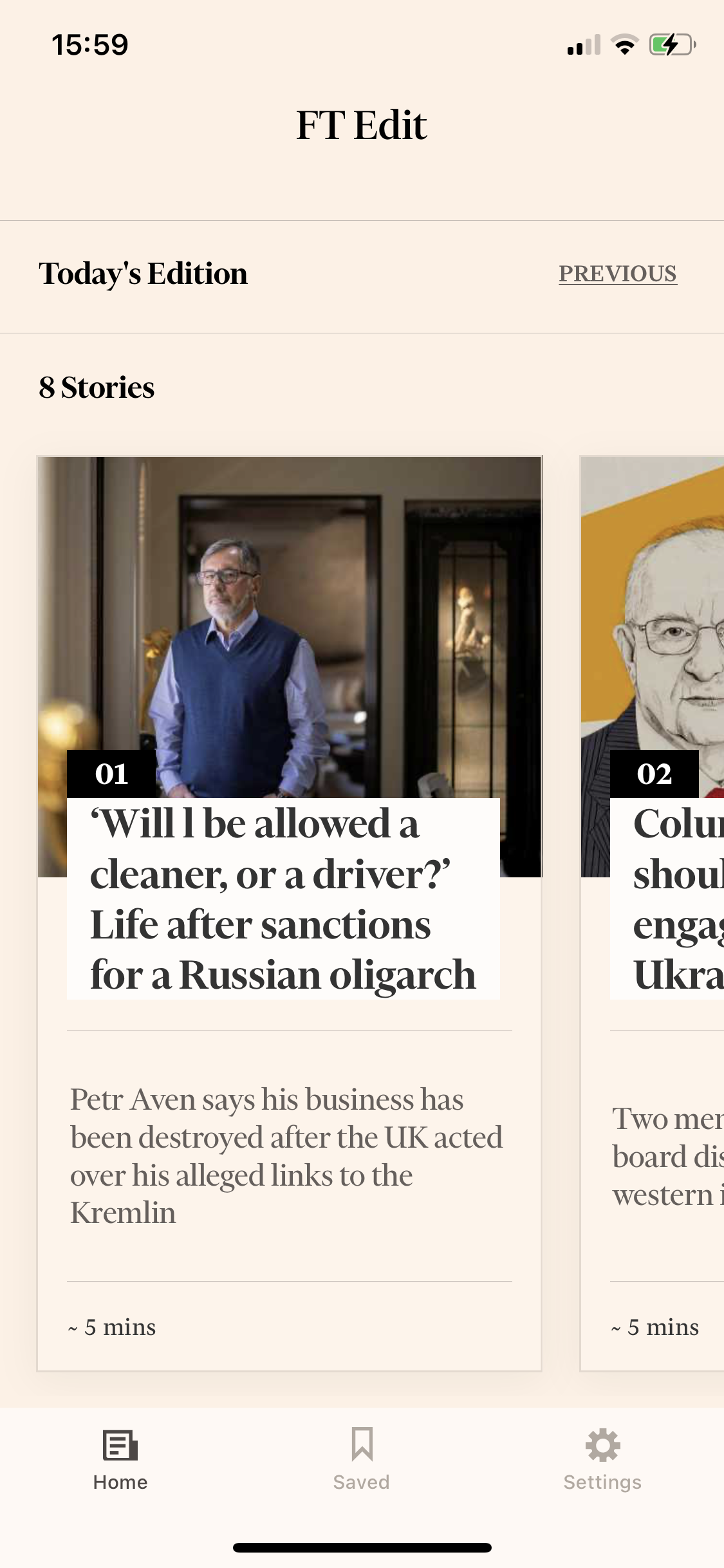
The Financial Times has launched FT Edit, a streamlined app it hopes will attract an audience beyond its traditional, professional readers.
The app, which is the FT’s first major product launch in a decade, will provide a curated, daily selection of eight articles at 8am each weekday. At weekends, subscribers will see a “best of the week” selection.
It will be free for the first month after launch and then cost 99p per month for the following six months – rising to £4.99 a month thereafter.
Its new editor Malcolm Moore, previously the FT’s tech news editor, told Press Gazette that the goal of the product is not to tempt users into full subscriptions.
Instead, he said, the aim is to tap into the 26 million people who follow the FT on social media, few of whom currently subscribe.
Moore told Press Gazette: “We’re really confident in our reporting. We’ve invested a lot in our reporting. And I think we want to show it off a little bit more.”
The top of the app will feature in-depth analysis of the big stories of the day. It will also feature the FT’s most popular opinion writers and some FT Weekend and archive content.
The launch comes on the back of news this month that the FT had hit one million paying digital subscribers.
Moore said these subscribers are its “core audience; we would call them ‘professional readers’ and that just means they’re willing to pay the high price of the FT because they need the information in there to do their jobs. They need to know M&A activity, what the bond markets are doing, all that kind of stuff.
“This app is intended for a different audience. The audience that we are now looking at is much, much wider. Like – there are 26 million people who are signed up to FT social media channels in one way or another.
“So we know that there are 26 million people out there that know the FT brand. They probably have clicked on a link on Twitter or, you know, during the pandemic, seen [data journalist] John Burn-Murdoch’s work.
“So what we want to do is we wanted to test whether we could offer those people some FT journalism that they would value in a different format. And we’re offering it at a much lower price point, obviously.”
At 99p per month FT Edit costs a fraction of the £35 per month charged for a full FT digital subscription.
Asked about the risk of full FT subscribers downgrading to FT Edit, Moore said: “We’ve definitely been worried about that. We’ve had lots of conversations about that.
“I think the answer is that we’ve designed it carefully to try to avoid that as much as possible. And of course, we will be paying very close attention to whether that happens.
“In terms of design, what you will not get with FT Edit is news – breaking news. There’s not going to be any breaking news on this app.
“So if you need to understand what is going on in financial markets, or what is going on to help do your job, this is not the right app for you.”
Instead, he said the new app would be right for people who want a “little bit more understanding of what’s going on” or some “depth and quality”.
“The other thing, of course, is that it’s a mobile app only,” Moore added. “It has a certain time and place in your day that is separate from when you’re in front of your desktop, or however else you consume your news.
“So we don’t think that our current FT readers will be able to live with just this app alone. But we’ll be keeping an eye on it.”
FT Edit entered beta testing in January with a trial audience of around 500 friends and family of FT staff.
“The problem with friends and family testing is, of course, they are people who are our friends and families, right?”, said Moore. “So they’re going to be nice to us.”
But he said it also meant they are not the FT’s traditional target audience.
“The hypothesis that we had was that the audience we wanted – they’re people who are tired of doom scrolling, they’re tired of the endless news cycle, they’re tired of just having so much information thrown at them all the time. And they’re ending their days really not coming away with much of a larger understanding about the news.”
The testers reported being surprised at their experience on the app.
“People have come back to us and said: ‘Okay, it is minimal, but actually, we get it. And this is interesting to us… This is stuff that we had no idea the FT does’,” Moore said. “‘We were kind of expecting just lots of economics news and business news – and there doesn’t seem to be that much of that in there.’”

Malcolm Moore. Picture: Financial Times
Despite the unusual beta test demographic, Moore said the FT also carried out substantial research trying to identify who exactly it would target with FT Edit.
“These readers are really engaged with the news, they are probably reading the news or consuming news somewhere else every day,” he said.
“But they’re expressing some dissatisfaction with what they’re getting. Either they feel that the news that they’re getting is politically slanted, and they want something that’s more neutral, or they’re not getting enough in-depth stuff.
“In terms of age, they skew both slightly older and slightly younger than the FT audience.
“If you imagine that your professional readers are people who are actually doing things every day, then the slightly older cohort might be very senior management, or retired – [they’re at] the point where they don’t need to make day-to-day trading decisions or financial decisions, but they want to stay on top of the news, they’re still engaged.
“The younger cohort are those people who are civic-minded, they really want to be on top of what’s going on. They understand that it’s important for them to know what’s happening in the world. But again, they can’t afford, or they don’t want to pay, for a full FT subscription.”
For now, stories are hand-curated by Moore and his team but this may not always be the case.
“We know of course that personalisation is something that people have come to get used to – but also, we’re not sure where they are in that. We’re not sure how comfortable they are with computers picking stuff for them.
“So it’s nice and fun to have this little sandbox over here, where we can say: ‘Okay, well, let’s see if maybe the app will personalise a couple of stories a day for you. Maybe you’ll be able to pick topics that you’re interested in.’”
Asked whether he thought the FT Edit model might work for other publishers, Moore said: “I think it works really well for us because so few people know what the FT does.
“We’re not a mainstream newspaper. We’re really a niche newspaper. And when we’ve done the customer testing, a lot of people haven’t heard of us, or they’ve been really surprised by the stuff that’s been put in front of them.
“For other newspapers, people are much more familiar with what they do. So I don’t know that this format would be something that they would consider.
“But I do think it is true that there’s a lot of information out there, and people are looking for a guide through it.”
At present, the app is being curated for a UK audience, although the app is downloadable worldwide for those who are interested in it and Moore foresaw curation teams in other regions coming in time.
“What we have out here now, and what this is gonna look like in a year’s time – it’s going to be totally, totally different,” he said.
“It’s not only the first new product we’ve launched in ages. We’ve tried to adopt a different mindset releasing it. Because, again, the FT is very cautious – we’re always really cautious with our brand. We don’t like to put things out that aren’t perfect.
“But the whole ethos behind this is we put out something that is a minimum viable product and we improve it… this is just the beginning of the journey, as it were.
“This is a big experiment for us. We’re going to be doing lots of different things on this app. And so what you see now may not be how it is in a month’s time, or six months’ time, or 12 months’ time. It will change and evolve.”
Moore said the project has had “very strong support” internally with bosses “treating it as an experiment, but they really want to see how far it can go”.
He added: “Touch wood, unless literally nobody downloads it or unless all the current FT subscribers download it, it’s not going to be going away anytime soon.”
Picture: Financial Times
Email pged@pressgazette.co.uk to point out mistakes, provide story tips or send in a letter for publication on our "Letters Page" blog



